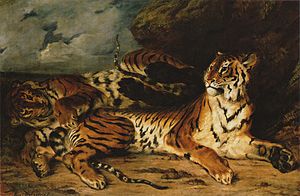art.wikisort.org - Painting
A Young Tiger Playing with its Mother is a painting of 1830–31 by French artist Eugène Delacroix depicting two enormous tigers "playing" with each other. Painted early in his career, it shows how the artist was attracted to animal subjects in this period.[1] The painting was exhibited at the Salon of 1831, and archives of Delacroix's will executor, Achille Piron, revealed that the painter had paid 1,200 francs to insure it.[2] It belonged to M. Maurice Cottier and now is on display at Room 77 of Louvre in Paris.
| A Young Tiger Playing with its Mother | |
|---|---|
 | |
| Artist | Eugène Delacroix |
| Year | 1830–31 |
| Medium | Oil on canvas |
| Dimensions | 131 cm × 194.5 cm (52 in × 76.6 in) |
| Location | The Metropolitan Museum of Art, New York |
Influence and analysis
Sweetly, the young background tiger slopes in his mother in the foreground, both running into rocks and under a cloudy sky. Some authors have written that Delacroix's animals paintings were made using his pet cat as a model.[3] And although it seems that the painting inspiration is due to one of his visits to the Jardin des Plantes zoo to see the tigers play with his friend Antoine-Louis Barye (an animal sculptor), Delaroix was always more content to observe his own cat.[4]
The piece was in some way influenced by Rubens and is very opposite of Delacroix's violent Tiger Hunt, both (and others Delacroix painting in this subject) capturing the ferocity and tenderness that these animals are capable of.[4] Delacroix could paint two different works that shows a discrepancy of the tigers behavior. In fact, tiger cubs play in their first years of life because it prepares them for hunting, stalking, climbing and fighting in the grown phase.[5] Tigers and great cats are frequent motifs in Eugène's works (see the following section).
These paintings, along with A Young Tiger Playing with its Mother, can be interpreted as a form of the artist displaying human emotions and passions personified as tame and fierce animals. For example, Delacroix wrote in his Journal of the time: "Men are tigers and wolves driven to destroy one another".[6] His friend Théophile Gautier saw a resemblance between him and manner and those of these great cats that he painted, writing: "His tawny eyes, with their feline expression, his slender lips stretched tight over magnificent teeth, his firm jaw line emphasised by strong cheekbones... gave his features an untamed, a strange, exotic, almost alarming beauty."[4]
In French, the picture is called Jeune tigre jouant avec sa mère. Its fierce but also divinely animals represents the "delight in wildness" that Romantic artists like Delacroix was fascinated with.[7] (His interest in wildlife reaches its peak with Ovid among the Scythians (1859) — where there's no feline, but barbarians people.) The painting of the mother and son tigers had a significant history to painter's works and to the time, as Lee Johnson wrote about it:
"A Young Tiger Playing with its Mother, Delacroix's largest animal painting to date, is shown at an exhibition in the Palais du Luxembourg for the benefit of citizens wounded in the July Revolution."[8]
Other paintings with similar theme
- Tiger, 36 × 53 cm
- Tiger and Snake. Oil on canvas, 13 × 161⁄4 in, 1862
- Sketch for a lion hunt, 1854
References
- Rhoda Eitel (Pierpont Morgan Library), From Leonardo to Pollock: master drawings from the Morgan Library, Pierpont Morgan Library, 2006.
- Pomarède, Vincent (1998). L'ABCdaire de Delacroix (in French). Luçon: Flammarion. pp. 33, 66. ISBN 2-08-012578-8.
- Mike Venezia, Getting to know the world's greatest artists – Eugène Delacroix, Children's Press, 2003, p.27. ISBN 0-516-22576-6
- Gilles Néret, Eugène Delacroix, 1798–1863: the prince of romanticism, Taschen, 2000, p. 64. ISBN 3-8228-5988-5
- Sea World. Tigers – Birth and care of young Archived 25 December 2012 at the Wayback Machine. Consulted on 28 September 2010.
- Néret, 2000, p.64. Les hommes sont des tigres et des loups animés les uns contre les autres pour s'entre-détruire.
- Matt Cartmill, A View to a Death in the Morning: Hunting and Nature Through History, Harvard University Press, 1996, p.118-19. ISBN 0-674-93736-8
- Lee Johnson, The paintings of Eugène Delacroix: a critical catalogue, 1816–1831, Clarendon Press, 1981, p. xx. ISBN 0-19-817314-8
External links
- A Young Tiger Playing with its Mother – Olga's Gallery
На других языках
- [en] A Young Tiger Playing with Its Mother
[fr] Jeune Tigre jouant avec sa mère
Jeune Tigre jouant avec sa mère (ou Étude avec deux tigres) est un tableau d'Eugène Delacroix peint entre 1830 et 1831. La peinture à l'huile sur toile a été réalisée au début de sa carrière. Mesurant 130,5 × 195 cm, elle est exposée au Musée du Louvre.[ru] Молодой тигр, играющий со своей матерью
«Молодой тигр, играющий со своей матерью» (фр. Jeune Tigre jouant avec sa mère) — картина французского художника Эжена Делакруа, написанная в 1830—1831 годах. На картине изображены два огромных тигра, «играющих» друг с другом. Написанная в начале карьеры художника, полотно показывает, как Делакруа в тот период привлекали сюжеты с животными[1]. Картина была выставлена в Парижском салоне 1831 года[2]. Она принадлежала Морису Коттье. Находится в коллекции Лувра (зал № 77) в Париже.Другой контент может иметь иную лицензию. Перед использованием материалов сайта WikiSort.org внимательно изучите правила лицензирования конкретных элементов наполнения сайта.
WikiSort.org - проект по пересортировке и дополнению контента Википедии



